Student Technology Experiences
Students are arguably the single most important group of end users of the technologies that IT units develop, implement, and/or support. If the students are not happy with their campus technology experiences, then no one in their corresponding IT units should be happy. The good news is that students continue to think that IT units offer them quality technology experiences on their respective campuses. In 2017, more than three-quarters (78%) of students reported having either good or excellent overall technology experiences, a number that is similar to the 80% we observed in 2016.1 Less than 10% of students said their overall technology experiences are negative!
Experience with Wireless Networks
Maslow's hierarchy of needs emphasizes certain human needs (e.g., physiological needs for food, clothing, shelter) that must be met before other, more complex needs (e.g., safety, love and social belonging, self-esteem, and self-actualization) can be satisfied. Recently, that hierarchy has been cheekily updated to include Wi-Fi as a need that must be filled before any other needs can be met. Indeed, Wi-Fi may honestly be somewhat necessary for some to even find food, clothing, and shelter. Given the relationship between students' ratings of wireless networks and overall student technology experiences, there may be some truth to this popular meme.
We do know that students' overall experience with technology on their campuses is, in part, a function of their interactions with the wireless infrastructure and campus networks.2 A majority of students reported good to excellent experiences with the Wi-Fi in campus libraries (76%), classrooms (68%), general indoor public spaces (61%), and dormitories and student housing (51%) (see figure 1). But with almost half of students reporting subpar experiences in outdoor spaces, and nearly one in three students reporting subpar experiences with dormitory Wi-Fi (32%) and network performance (30%), IT organizations still have some work to do.
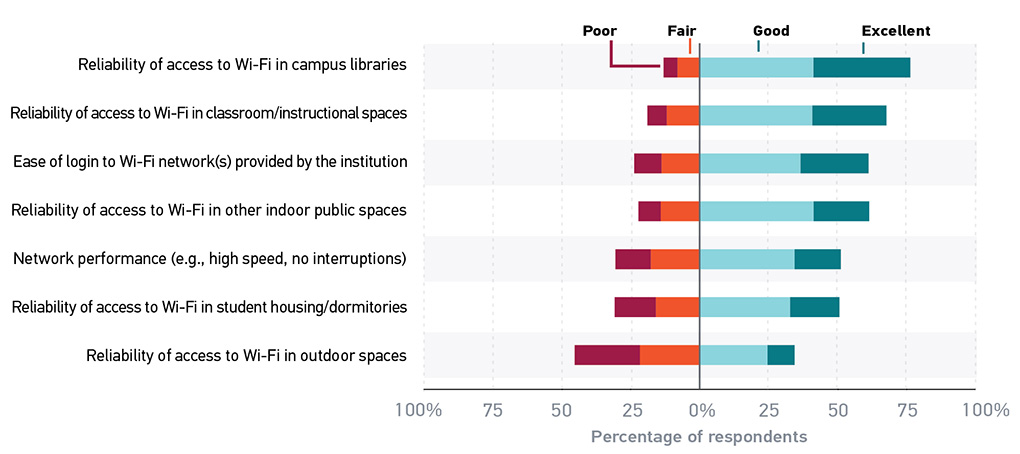
Limiting bandwidth in dormitories because students may be using the Internet for nonacademic purposes (e.g., streaming media, online gaming) punishes students who need robust wireless networks to conduct the business of being a student; it also ignores the fact that a student's dormitory is a home away from home and that some creature comforts can support the whole student. Moreover, in an era when physiological needs may have been replaced by Wi-Fi at the base of Maslow's hierarchy, institutions desiring to provide students with the best possible technology experiences should invest in increasing the capacity of their infrastructure in the places and spaces where students are giving them low marks.3
Technical Support
When there's something strange in your CPU, who you gonna call? Assuming a Class 5 Ecto-Clone is not actually haunting their laptops, then one might expect students to call the campus computer help desk for technical support. Students, however, take quite a different approach to fixing problems they have with their computing devices. Indeed, only a quarter (25%) of students include the college/university help desk services among their top 3 choices (see figure 2). Instead of seeking assistance from experts, students' top 3 choices for technical support reflect a DIY approach: They figure out solutions to their problems on their own (63%), search online resources such as Google and YouTube (62%), and/or simply ask their friends (51%).4 These behaviors match well with efforts to teach students as early as kindergarten and first grade5 to become independent problem solvers, especially when it comes to troubleshooting technology.6 The drop between students' primary and secondary sources of IT support is precipitous: Students are about half as likely to seek expert help from the help desk service (25%) and instructors (25%) as from their least frequent informal source. This pattern is even starker when compared with the magnitude of faculty who seek out the expertise of the help desk first, followed by themselves, the Internet, and their peers.
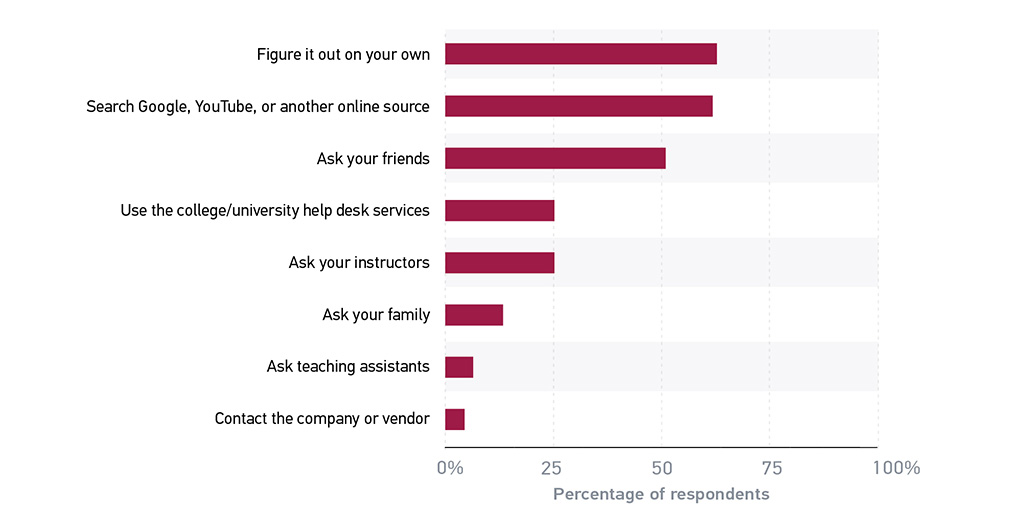
Why is it that students eschew the technological expertise of the campus help desk in favor of doing it themselves or asking their friends? It certainly is not because they are digital natives and know everything there is to know about technology. Beyond the sheer balderdash of such an argument,7 our research has demonstrated previously that there are not really that many differences between today's students and their instructors in terms of how they use, relate to, and think about digital technology.8 It could be that students are novice learners who simply grab whatever information is available at their fingertips regardless of whether the information acquired is correct or efficiently obtained.9 More generously, maybe students see technology problems as opportunities to learn something for themselves via trial and error or online research, or they may have networks of friends who can teach them how to solve the problem. Less generously, help desks may be generally inhospitable to students and their needs (e.g., too long to get resolution of ticket; unaware of availability of services; a perception that help desks are mainly for faculty and staff; open only during business hours). Perhaps the spatial proximity of and access to potential sources of help—do it myself, look up what others have done, ask a roommate or peer down the hall, then call the help desk—shape the choices students make. Or, maybe calling the technology help desk simply is not the cool thing to do.
The truth is, we simply do not know why the campus technology help desk services that practically all campuses offer are not being used by students as much as we might expect.10 Understanding this phenomenon should be important for campuses that find their technology support services underutilized by students. Leveraging ticketing systems and other sources of analytics related to the help desk to better meet student demands for technology support would be a good start. Additionally, IT units (perhaps in conjunction with centers for teaching and learning) can deploy a brief questionnaire to better understand students' reasons for not using the technology support services offered. For instructors, staff in centers for teaching and learning, and others who interact frequently with students, consider pushing IT resources to students in assignments, syllabi, and other materials to help them think about how to find correct answers to their problems more efficiently than by trial and error, sifting through thousands of DIY sources, and/or asking a friend down the hall.
Information Security Practices and Training
For the second year in a row and the third time since 2008,11 information security is first on the list of the EDUCAUSE Top 10 IT Issues, highlighting the urgency with which institutions need to consider "developing a holistic, agile approach to reduce institutional exposure to information security threats."12 Providing students with information security training should be an obvious part of any higher education strategy to mitigate potential vulnerabilities. Very few students, however, said that their institution provides either mandatory (4%) or optional (10%) information security training; about twice as many students (26%) said no information security training options are available to them. Perhaps more worrisome is that about 60% of students simply do not know whether information security training is available to them on their campuses. Of those students with access to training, only about a third (32%) participated during the past year, but nearly all of those who did participate (88%) found it to be at least moderately useful.
There are some discrepancies between what information security training students report is available and what institutions claim to provide. According to data from the 2015 Core Data Service (CDS), more than a quarter of institutions provide some sort of mandatory information security training for their students, most of which focuses on acceptable use policies.13 Regardless of these differences, the fact remains that students are comparatively overlooked by campus information security efforts. For example, a majority of colleges and universities have mandatory information security training for staff and/or faculty that often moves beyond usage policies to cover regulatory compliance, security policies, and self-defense tactics.14 Institutions likely focus their information security training resources on faculty and staff for at least two basic reasons: 1) The cost associated with training students, who clearly outnumber faculty and staff, is considerable; and 2) even though the sheer number of students (and their devices) increases the possible points of institutional vulnerability, students do not have access to the confidential, private, and restricted information that staff and faculty need to protect.
Despite the lack of institutional training provided for students (or the lack of students' awareness of training opportunities), students do appear to be pretty savvy with respect to information security issues. Indeed, overwhelming majorities of students reported technology habits that suggest that they take information security seriously (see figure 3).
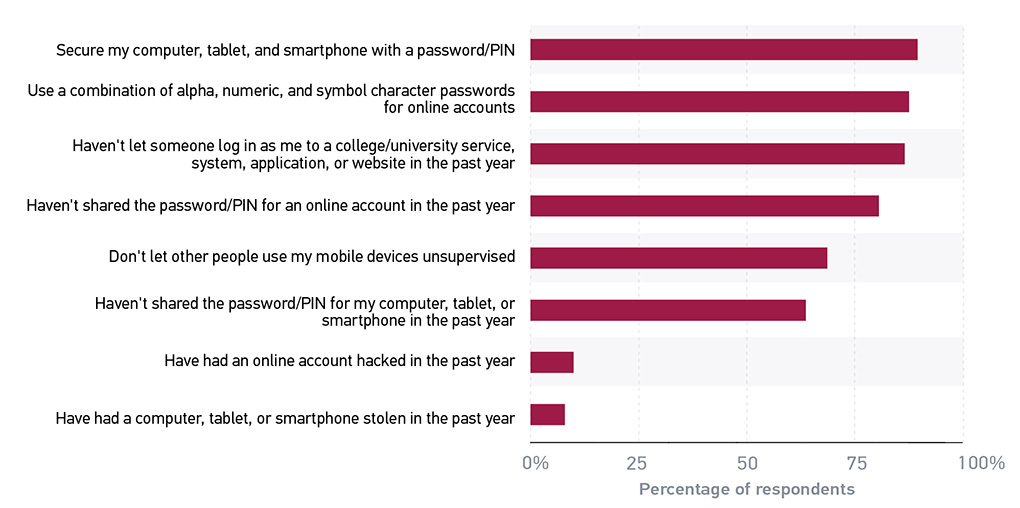
Given that there is almost always room for improvement, we offer the following recommendations:
- Increase the number and type of security training options available to students.
- Explore online options as a cost-effective means to provide information security training at scale.
- Advertise training programs better to raise awareness of options to students for existing (or future) training opportunities.
- Expand student security training beyond usage policies.
- Make campus information security resources more visible to students.
- Consider the impact of two-factor authentication or simpler alternative password protocols15 on the quality of the information security regime and the long-term campus security culture.
These actions can help cultivate a culture of security on campus and promote long-term information security that will provide students with the skills and knowledge necessary to protect themselves (and their employers) once they graduate.16
Device Ownership
Students continue to own a considerable number of digital technologies (see figure 4), with nearly all students having more than one device and roughly a third each owning two, three, and four or more. Despite near market saturation of smartphones and laptops, the percentage of students who own those devices continues to increase! Compared with 2016 data, students' smartphone ownership increased one percentage point to 97% and laptop ownership crept up two points to 95%. Although about half of students own tablets, our data suggest that the tablet market for students may be shrinking; not only did we see a seven-point drop in ownership since 2016, but also 90% of those who do not own a tablet told us that they have no intention of purchasing one. For the first time in a couple of years, we asked students about desktop computer ownership. About 3 in 10 students continue to own a desktop, but 7 in 10 do not and do not plan to own one.
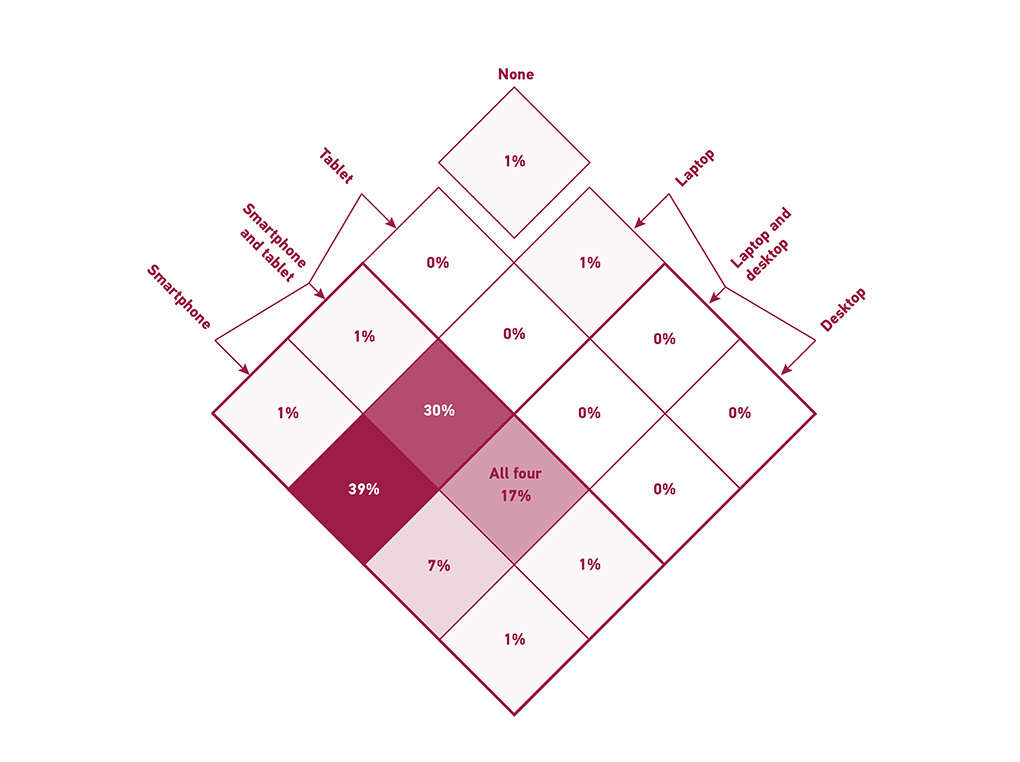
One of the clearest themes that emerged from these data is that student ownership of digital technologies is converging on two devices: laptops and smartphones. Laptops, as we know well, are the academic workhorse of the modern college and university student.17 And, although the ubiquitous smartphone is not used as much for academic work as the laptop (see figure 5),18 about three-quarters of students (78%) consider their phones to be at least moderately important to their academic success. That both of these devices are used and viewed as important by students may be a product of their functionality; that is, laptops handle the heavy lifting of student work (e.g., composition, statistical analysis, graphics), while smartphones are conducive to more agile tasks (e.g., communication, easy information access, photography). Tablets, which lie somewhere in between—not as powerful as laptops, not as agile as smartphones—appear to be falling from favor. The attractiveness of tablets' touchscreen capabilities are now being challenged by similar technology in laptops; from the other end, the allure of larger screen sizes on tablets may be diminishing as the size of smartphone screens increases.
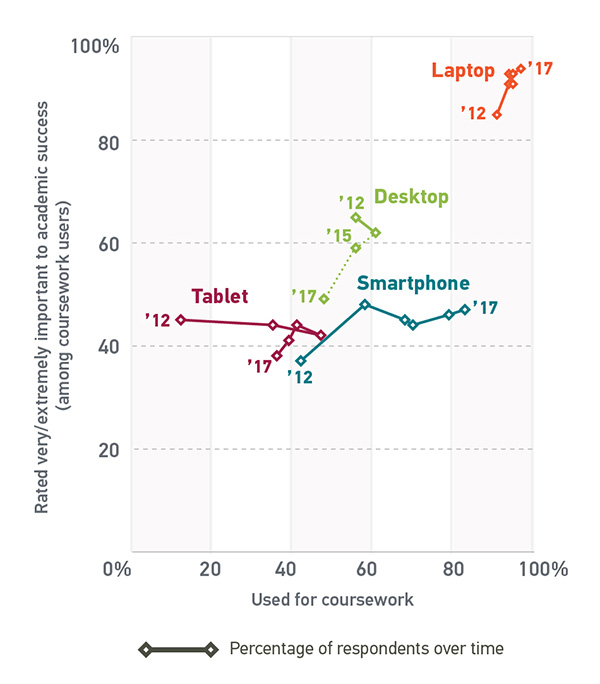
What should we make of all of this? For institutions that supply devices for in-class activities, laboratory exercises, and/or training, it might be worthwhile reconsidering investments in tablets, as laptops are seen as more useful and important to student success. This does not necessarily mean that institutions should completely divest themselves of providing (or even supporting) tablets; instead, we recommend striking a balance between laptops and tablets that fits institutional budgets, faculty and departmental needs, and student demands. For the 52% of faculty who ban or discourage the use of smartphones in the classroom, stop it. Although about 40% of students confess to using their smartphones for off-task activities, only 18% do not use them for any on-task activities. And indeed, what faculty member can truthfully claim to never having used a laptop or smartphone for off-task activities in a faculty or committee meeting? Our data also suggest that students who use their smartphones purposefully to do things like taking notes or participating in instructor-directed activities are less likely to use them to engage in nonclass activities. If students are to learn how to become independent learners and thinkers, instructors need to abandon the in loco parentis posture, overcome the fear of being wrong or "looking stupid" in the classroom,19 and adopt proven student-centered pedagogical approaches20 such as active learning21 that deliberately leverage and incorporate the learning tools students carry with them.
Notes
-
D. Christopher Brooks, ECAR Study of Undergraduate Students and Information Technology, 2016, research report (Louisville, CO: ECAR, October 2016): 14.
↩︎ -
D. Christopher Brooks, ECAR Study of Undergraduate Students and Information Technology, 2016, research report (Louisville, CO: ECAR, October 2016): 17–18.
↩︎ -
FSR Team, "Dorms—Not Just for Sleeping Anymore," FSR, February 10, 2017.
↩︎ -
A plurality of students (20%) selected themselves, the Internet, and friends as their top 3 sources for technology help.
↩︎ -
See Ask 3 Then Me for an excellent example from the K–12 context.
↩︎ -
See "ISTE Student 6: Guiding Students to Troubleshoot More Autonomously" for some practical tips to help students take more control over their technology problems.
↩︎ -
For more on this, see Michael J. Coren, "New Research Shows 'Digital Natives' Are No Better at Technology Than the Rest of Us," Quartz.com, July 30, 2017; and Paul A. Kirschner and Pedro De Bruyckere, "The Myths of the Digital Native and the Multitasker," Teaching and Teacher Education 67 (October 2017): 135–142.
↩︎ -
For more on student and faculty attitudes, dispositions, and usage patterns of technology, respectively, see D. Christopher Brooks, ECAR Study of Undergraduate Students and Information Technology, 2016, research report (Louisville, CO: ECAR, October 2016): 8–9, 45–46; and D. Christopher Brooks, with a foreword by John O'Brien, ECAR Study of Faculty and Information Technology, 2015, research report (Louisville, CO: ECAR, October 2015): 11, 54–56.
↩︎ -
Claire Warwick, Jon Rimmer, Ann Blandford, Jeremy Gow, and George Buchanan, "Cognitive Economy and Satisficing in Information Seeking: A Longitudinal Study of Undergraduate Information Behavior," Journal of the American Society for Information Science and Technology 60, no. 12 (December 2009): 2402–2415; Chandra Prabha, Lynn Silipigni Connaway, Lawrence Olszewski, and Lillie R. Jenkins, "What Is Enough? Satisficing Information Needs," Journal of Documentation 63, no. 1 (2007): 74–89.
↩︎ -
According to 2015 EDUCAUSE CDS data, 100% of institutions offer help desk services, and 92% offer self-service help options. See the CDS Almanac for All U.S. Institutions for more information on help desk services offered.
↩︎ -
See the Top 10 IT Issues graphic.
↩︎ -
Susan Grajek and the 2016–2017 EDUCAUSE IT Issues Panel, "Top 10 IT Issues, 2017: Foundations for Student Success," EDUCAUSE Review, January 17, 2017.
↩︎ -
See the CDS Spotlight on Information Security.
↩︎ -
Ibid.
↩︎ -
Nick Statt, "Best Practices for Passwords Updated after Original Author Regrets His Advice," The Verge, August 7, 2017.
↩︎ -
The EDUCAUSE Cybersecurity Initiative supports higher education institutions as they improve information security governance, compliance, data protection, and privacy programs. EDUCAUSE volunteers have created an Annual Campus Security Awareness Campaign that provides ready-made content that information security professionals and IT communicators can integrate into year-round campus communications to give students, faculty, and staff a steady stream of privacy and security awareness information.
↩︎ -
In 2017, 99% of students claimed that their laptops are at least moderately important to their academic success; 78% said they are extremely important.
↩︎ -
Nearly 6 in 10 students reported using their smartphones for half or more of their courses, but only a quarter of them said that they use their phones for all of their courses in 2017. By contrast, 94% of students use their laptops in half or more of their courses; 71% use them for every single course they take.
↩︎ -
David Matthews, "'Fear of Looking Stupid'," InsideHigherEd, July 6, 2017.
↩︎ -
Aubree Evans, "Active Learning in the Age of Classroom Cellphones," InsideHigherEd, July 11, 2017.
↩︎ -
See Michael Prince, "Does Active Learning Work? A Review of the Research," Journal of Engineering Education 93, no. 3 (July 2004): 223–231; and Scott Freeman, Sarah L. Eddy, Miles McDonough, Michelle K. Smith, Nnadozie Okoroafor, Hannah Jordt, and Mary Pat Wenderoth, "Active Learning Increases Student Performance in Science, Engineering, and Mathematics," PNAS 111, no. 23 (June 10, 2014): 8410–8415. For more information, see the annotated bibliography "Evidence for the Efficacy of Student-Active Learning Pedagogies" by Jeffrey E. Froyd.
↩︎